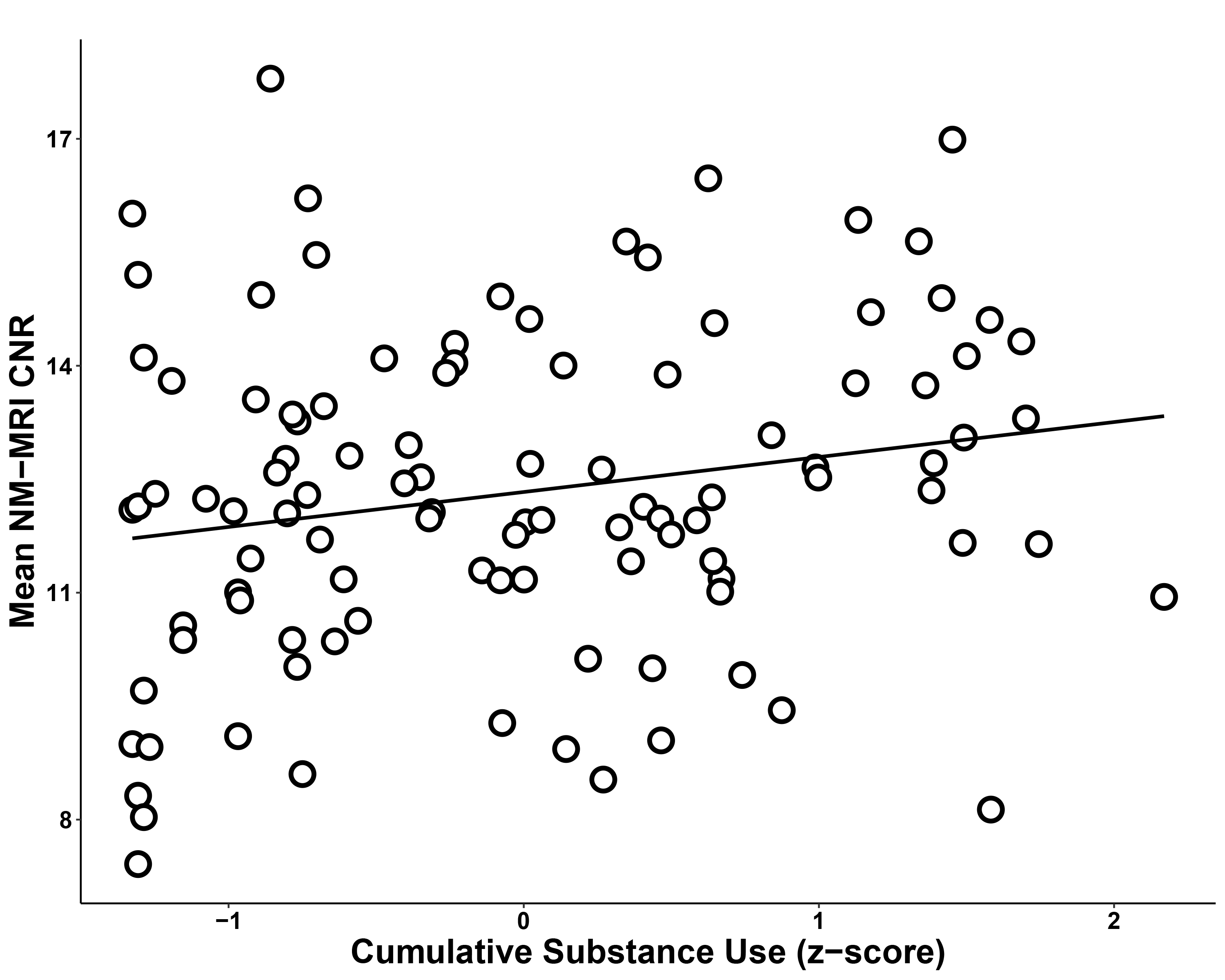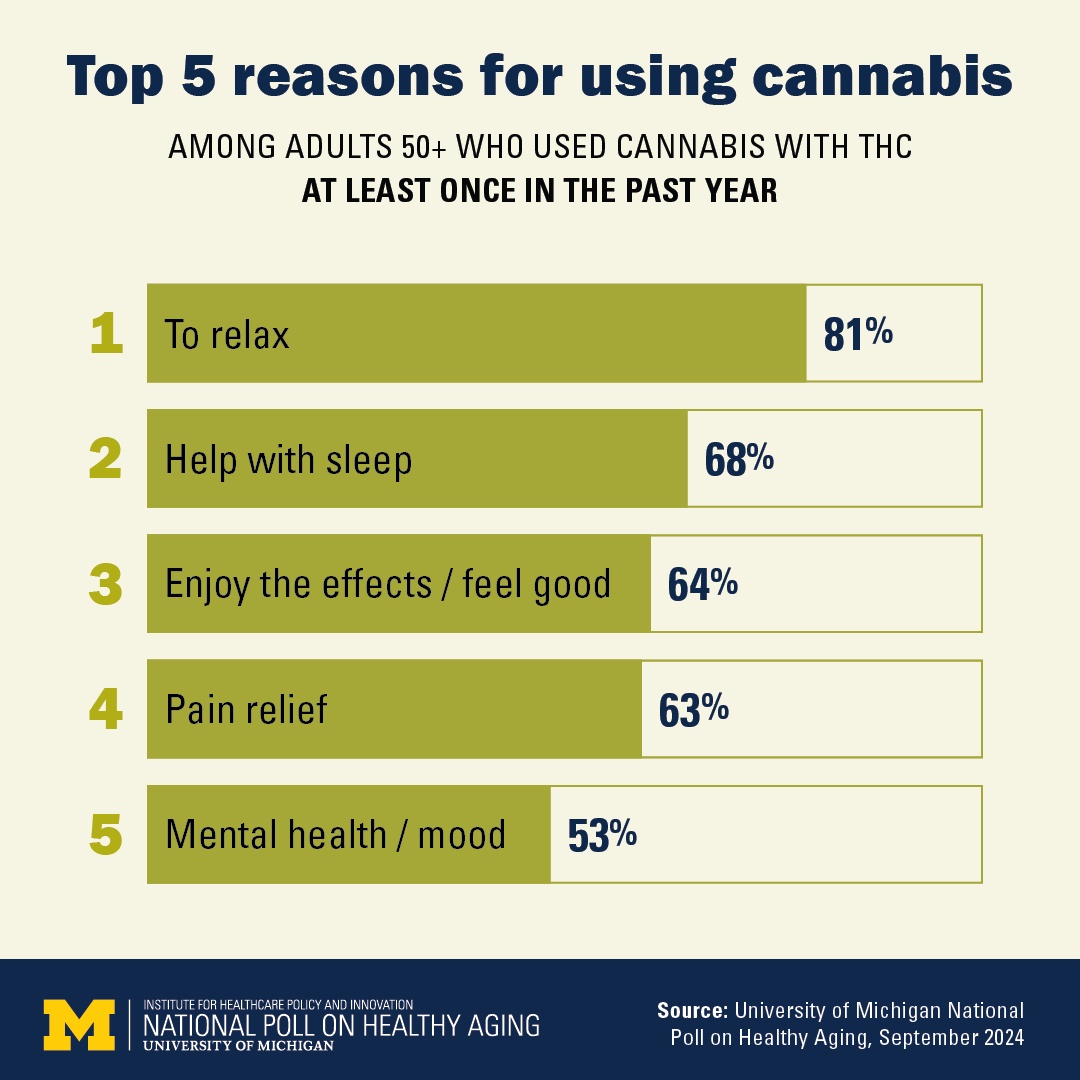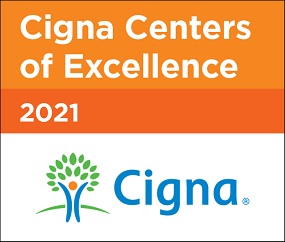Members of the Brain Health Institute at Rutgers mark a decade of innovation with an awards ceremony honoring faculty
Tag: Substance Use

Brain Imaging of Neuromelanin May be Key to Understanding Extensive Substance Use
A study that used a specialized type of magnetic resonance imaging (MRI), named neuromelanin-sensitive MRI, showed that this type of MRI signal was increased in regions of the midbrain in young adults ages 20 to 24 who had an extensive alcohol and drug use history. The findings are published early online in the American Journal of Psychiatry.

Cannabis and older adults: Poll shows current use patterns, beliefs and risks
One in 5 older adults used cannabis products that include THC in the last year. Among them, 20% said they drove within 2 hours of using cannabis, and a similar percentage said they experience at least one potential signs of addiction.
Virtual learning detrimental to school attendance, especially in districts with higher poverty rates, study finds
Since the COVID-19 pandemic, rates of chronic absenteeism have nearly doubled across the nation for students in kindergarten through grade 12.This increase was tied to the mode of instruction during the early years of the pandemic.
National Academy of Medicine Selects FAU for Substance Use, Opioid Crises Collaborative
FAU joins the National Academy of Medicine’s Action Collaborative on Combating Opioid Crises. This pilot project, involving more 80 organizations, aims to enhance coordination and address addiction challenges through collaboration among public, private and nonprofit sectors.
Exploring the underlying emotions that lead to alcohol and cannabis use
Theoretical models of alcohol and cannabis use disorders often focus on the idea that people consume alcohol and cannabis use to regulate their negative emotions – in other words, to make themselves feel better. New research does not support this idea, finding instead that people mostly consume alcohol and cannabis in their daily life when they are experiencing positive emotions.
Biden Administration Announces Initiative on Life-Saving Overdose Reversal Medicine
Cynthia Awadzi, is a licensed family nurse practitioner and a psychiatric mental health nurse practitioner at the GW School of Nursing. She can speak to a number of aspects of the national opioid crisis, including treatment options, risk factors and…
NIH grants support UCLA and Charles Drew University researchers’ efforts to end HIV epidemic
The National Institutes of Health (NIH) has granted $2.1 million to UCLA’s Center for HIV Identification, Prevention, and Treatment Services (CHIPTS) and the UCLA-CDU Center for AIDS Research (CFAR) to support four research projects and an implementation science consultation hub.
SMART Recovery Meetings for Alcohol Recovery Appeal to People with More Social and Economic Stability and Lower Spiritual Leanings, Compared to Alcoholics Anonymous
Certain characteristics of people seeking remission from alcohol use disorder (AUD) are linked to their choice of recovery meeting, a new study suggests. Informal peer recovery groups—mutual-help organizations—play a crucial role for many individuals with AUD or other drug disorders. Such groups are proliferating and differ substantially in approach.
Understanding the Surge in Cannabis Use among Pregnant and Postpartum Women in the US
Rutgers researcher leads effort to map associations between mental health disorders, cannabis use and cannabis use disorder during pregnancy and postpartum in the United States
Do Prisons Hold the Key to Solving the Opioid Crisis?
Rutgers study finds improved prison reentry programs could help flatten the rate of opioid overdose deaths in the U.S.
Emerging adults who experience pain and related anxiety may engage in high-risk drinking
Emerging adults – those aged 18 to 24 years –who experience pain are more likely to engage in high-risk patterns of alcohol use such as binge drinking. Anxiety caused by pain may be what motivates unhealthy coping strategies such as excessive drinking as a form of escape/avoidance. These results and others will be shared at the 46th annual scientific meeting of the Research Society on Alcohol (RSA) in Bellevue, Washington.
Intoxicated Teenage Rats Wearing “Fitbits” Experience Sleep Disturbance Long After Withdrawing from Alcohol, Underlining Ongoing Struggles for Humans who Drink Heavily in Adolescence
Adolescent rats exposed to alcohol vapor experience persistent sleep disruption after withdrawal, as measured by Fitbit-like tracking devices, a new study has shown. The findings, published in Alcohol: Clinical & Experimental Research, provide insight into the relationship between sleep disturbance and heavy drinking in humans. Although adolescents and young adults may be particularly affected by sleep disturbances associated with drinking, little is known about that connection or its mechanisms. Plausibly, the link between disrupted circadian rhythm and substance use may operate in both directions; for example, irregular sleep cycles, including daytime sleepiness, have been implicated in teen substance use. Daytime sleepiness and disrupted activity in humans can be measured using wearable tracking devices, complementing EEG metrics taken at night. Nevertheless, genetic and lifestyle factors make the relationship between alcohol and sleep problems challenging to study in humans, and ro
Study Finds Disparate Gender Differences in Victims of Child Sex Trafficking
Youth involved in sex trafficking have extensive victimization experiences during childhood, and these experiences vary by gender. In the nationally representative study, 75 percent were males and 25 percent were females. Almost two-thirds of the girls were molested as a child, half were raped, and three-fourths were emotionally abused as a child, compared to 36 percent of males who were molested, 31 percent who were raped, and 37 percent who were emotionally abused. Eighty percent of females reported three or more victimization types compared to males (49 percent), and 31 percent of females experienced all five types of prior victimization compared to 11 percent of males.

Group working with University of Kentucky researchers to meaningfully involve people who use drugs
A group of University of Kentucky researchers in the Substance Use Priority Research Area is working to make studies more responsive and inclusive. The group formed a community advisory board, called the Survivors Union of the Bluegrass, including those who identify as people who use drugs and/or people in non-abstinence-based recovery.

Mental health, substance use issues prevalent among nonpsychiatric emergency room patients
A new study found that about 45% of patients who visit the emergency department for physical injuries and ailments also have mental health and substance use problems that are often overlooked.
IU researcher creates virtual reality experiences to aid substance use disorder recovery
Researchers are combining psychological principles with innovative virtual reality technology to create a new immersive therapy for people with substance use disorders.
Becoming Sober – A ‘Voice’ for Mothers Navigating the Child Welfare System
Stigmatized and ignored, pregnant women and mothers with substance use disorders often are voiceless. Researchers used documentary photography as platform to enable mothers in recovery to be heard. Results reveal a shared perception. For mothers with a substance use disorder involved with the child welfare system it is easy to fail and hard to succeed. The emotional jeopardy of child welfare system interactions was described by the mothers to result in feelings of defeat and an increased vulnerability to reoccurrence of substance use.
Trauma history and alcohol’s effects on the brain combine to make women more vulnerable to alcohol use disorders
Prior research has demonstrated greater addiction vulnerability in women; for example, women advance from casual substance use to addiction at a faster rate, experience more severe withdrawal symptoms, exhibit higher rates of relapse, and have less treatment success than men. A new study shows that biobehavioral interactions in alcohol use disorders (AUDs) among women are cyclical in nature: women’s greater risk of personal histories of trauma coupled with a greater vulnerability to alcohol-related brain deficits can lead to more severe AUD effects.
Science is Rejecting Language About Alcohol and Drugs That Perpetuates Stigma and Worsens Outcomes — But Must Do More
Scientists investigating substance use are making progress on eliminating stigmatizing language that can perpetuate negative biases and worsen outcomes, according to a new analysis of published research articles. Nevertheless, the field has further to go.
Opioids: 4 ways to reduce harm, overdose and death
As America sees a record number of overdose deaths, taking action to reduce harm and tragedy due to opioids is vital. Here, three providers with expertise in substance use disorder care share ways individuals, communities and health care providers can help save lives.
Mental health and substance use among adolescents experiencing homelessness in the United States
In a new paper published in JAMA, researchers evaluated mental health and substance use among homeless and housed high school students surveyed voluntarily and anonymously in 2019.
Forecasting the Future Alcohol Burden: Binge Drinking Rates to Converge in Young Men and Women, and Increase Among 29- to 30-year-olds, by 2040
A study has revealed important gender and age differences in forecasted future levels of binge drinking, and highlighted key factors underlying these trends.
Case Western Reserve University receives $16M federal grant to launch major research center on substance use and HIV
Thanks to a new $16 million, five-year grant from the National Institute on Drug Abuse of the National Institutes of Health, Case Western Reserve University is launching a multi-institutional research effort dedicated to deepening understanding of the relationship between substance use and HIV.
IU experts available to talk about recovery month.
Bloomington, Ind. – September 1 marks “Recovery Month,” a national annual effort to increase awareness and understanding of mental and substance use disorders and to celebrate people in recovery. This year’s theme is “Recovery is For Everyone: Every Person, Every…
Half of adults with ADHD have had a substance use disorder
Half of adults aged 20-39 with attention deficit hyperactivity disorder (ADHD) have had a substance use disorder (SUD) in their lifetime according to new research published online ahead of print this month in Alcohol and Alcoholism.
Alcohol use among sexual minority adolescents is linked to discrimination and stigmatization
Sexual minority adolescents – lesbian, gay, or bisexual youth – are at an increased risk for substance use, including alcohol. A new study finds that discriminatory and stigmatizing experiences may be to blame. These results and others will be shared at the 44th annual scientific meeting of the Research Society on Alcoholism (RSA), which due to the COVID-19 pandemic will be held virtually this year from the 19th – 23rd of June 2021.

Cigna Designates Henry Ford Maplegrove as a Center of Excellence for Substance Use Treatment
WEST BLOOMFIELD, MI (February 23, 2021)—Henry Ford Maplegrove Center is pleased to announce that it has been designated as a Cigna Center of Excellence for Substance Use. The designation recognizes top performing addiction recovery centers that provide patients with quality care, an exceptional experience and cost efficiency.

ISU researchers use data to help communities discover and solve biggest problems
The Data Science for the Public Good program, an Iowa State University project to help Iowa towns harness their data, has led to four offshoot projects to help support community recovery related to economic vulnerability, substance use and general support.

Experts available to speak about COVID’s impact on those with substance use disorder this holiday season
From a deadly pandemic to divisive politics, there were already plenty of reasons why someone could turn to substance abuse in 2020, let alone the holidays. Experts from Indiana University and the Regenstrief Institute are available to speak to the…

Opioid Use Disorder? Electronic Health Records Help Pinpoint Probable Patients
A new study suggests that patients with opioid use disorder may be identified using information available in electronic health records, even when diagnostic codes do not reflect this diagnosis. The study demonstrates the utility of proxies coding for DSM-5 criteria from medical records to generate a quantitative DSM-5 score that is associated with opioid use disorder severity. The study methods are unique in deriving a severity score that aims to mirror severity scores from more traditional interview-based diagnostic procedures.
Reducing Drinking Among US Veterans with Unhealthy Alcohol Use Might Improve Chronic Pain Symptoms and Reduce Other Substance Use
US veterans with unhealthy alcohol use who reduce their drinking may gain some improvement in chronic pain symptoms and use of other substances, according to a study in Alcoholism: Clinical and Experimental Research. Hazardous drinking is common in the US, and frequently co-occurs with chronic pain, depression and anxiety, and with tobacco, cannabis or cocaine use. Many people use alcohol and other substances to mask or self-manage pain and psychiatric symptoms, although there is little evidence to support such use. If, conversely, a reduction in drinking (or use of treatment for alcohol misuse) were to benefit co-occurring conditions or substance use, this could support an integrated approach to screening or treatment. The new analysis assessed the impact of drinking reduction on improvement of chronic pain, psychiatric symptoms, and other substance use among US veterans with unhealthy alcohol use – a population with high rates of these co-occurring conditions.
College Students with Disabilities at Greater Risk for Substance Abuse
College students with physical and cognitive disabilities use illicit drugs more, and have a higher prevalence of drug use disorder, than their non-disabled peers, according to a Rutgers study.
Sexual Minority Men Who Smoke Report Worse Mental Health and More Frequent Substance Use
Cigarette smoking is associated with frequent substance use and poor behavioral and physical health in sexual and gender minority populations, according to Rutgers researchers.
Clubs Closed? Study Finds Partygoers Turn to Virtual Raves and Happy Hours During Pandemic
People have traded in nightclubs and dance festivals for virtual raves and Zoom happy hours as a result of lockdowns during the COVID-19 pandemic—yet, many are using drugs in these socially distanced settings, according to a new study by researchers at NYU Grossman School of Medicine and the Center for Drug Use and HIV/HCV Research at NYU School of Global Public Health.
Lesbian, Gay, and Bisexual Older Adults at Higher Risk for Substance Use
Middle-aged and older adults who identify as lesbian, gay, or bisexual have higher rates of using certain substances in the past year than those who identify as heterosexual, according to a new study led by researchers at NYU Grossman School of Medicine and the Center for Drug Use and HIV/HCV Research (CDUHR) at NYU School of Global Public Health.
Expanding access and reducing stigma for mental health services
Serving in the Army National Guard has inspired one West Virginia University social work student to pursue a career combating stigmas surrounding mental health.
Childhood physical abuse linked to heavy cigarette use among teens who smoke
A new study in kids at risk for maltreatment shows that physical abuse, especially when they’re toddlers or teens, dramatically increases the odds that their adolescent experimentation with cigarettes will lead to a heavy smoking habit.